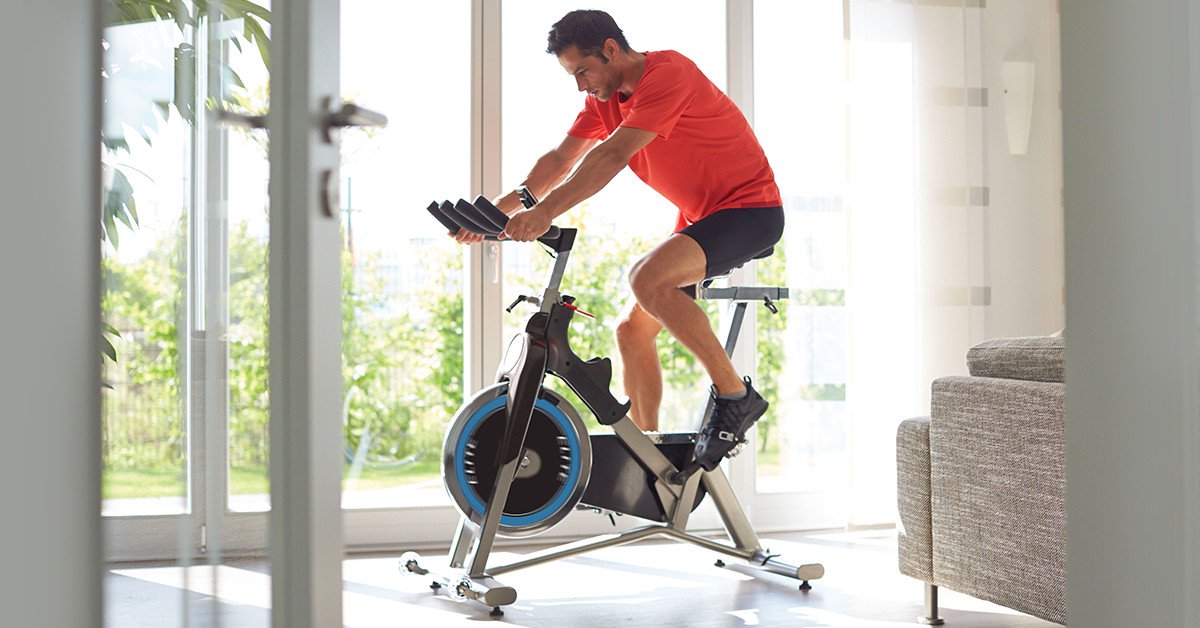
Avoid Unnecessary Injury with these Bike Alignment Tips
Highly adjustable, performance indoor cycles, such as the Horizon Elite IC7 are a great way to experience a customized workout that transfers well to road biking and indoor cycling classes. Taking the time to adjust your exercise bike into the proper position for your body and riding style will not only prevent injury, but also greatly improve the quality of your workout. Here are four tips on how you can avoid injury and ride more efficiently on your next home workout.
1. Adjust The Saddle Height
Your saddle height is the first step to setting your bike and is dependent on your height and leg length. Standing next to your bike, adjust the height to the height of your hip bone (as you are standing side by side with your bike). This is a good starting point for most people. Then climbing onto your bike, place your heels on your bike pedal and extend one foot to the bottom of your pedal stroke. If you have a very slight bend in your knee with the heel on the pedal, your seat is at the right height for your legs. Setting a seat height that is too low results in unnecessary strain on the knees, especially during heavy climbs and high resistance. A seat height that is too high will result in you needing to stretch to reach the bottom of your foot stroke, leading to strain in the feet, ankles, and hips.
2. Find The Right Saddle Position
The second adjustment to make on your bike is to position of the saddle forward and backward. While this is determined in part by your height, your flexibility and riding approach will also impact this position. As you sit in your preferred riding position on the bike, you want to ensure that your knees come slightly over the center of your foot but do not extend past the middle of your shoelaces. A position that is too far back will cause unnecessary strain on your knees and low back and a too far forward position will decrease your riding efficiency and place your torso in an awkward position.
3. Position The Handlebars
The position of the handlebars is determined by your riding style and desired comfort. A higher handlebar position is more forgiving than a low position. A position that is too low will lead to discomfort in the low back and put unnecessary tension into the neck and shoulders. Riders who favor a more aggressive riding position (think bottom back and lower torso), will tend to place their handlebars only slightly above seat height and increase the distance from the seat. While you might need to play with your settings and allow them to adjust as your riding style evolves, your ideal handlebar placement should allow you to ride comfortably without requiring you to put much weight into the handlebars. You should also be close enough to your seat to keep a slight bend in your elbows. As you ride, keep your weight off of the handlebars and push down through your legs and feet instead.
4. Find The Right Pedal Position
Once you are on your bike, it’s important to maintain a healthy foot position throughout your ride. Your exercise cycle is designed for you to ride with the ball of your foot over the center of the pedal. Your foot stroke should keep your heels level with the ball of your feet, allowing your toes to remain light. Many new riders tend to point their toes down through their pedal stroke, resulting in numbness in the feet and stress through the ankles and knees. Wiggling your toes occasionally as you ride and checking your heel position will help you to avoid this.
Benefits Of A Perfectly Aligned Exercise Bike:
While exercise bikes offer a low impact cardiovascular exercise that is easy on your joints and approachable for all levels of fitness, the wrong set-up can result in discomfort and injury throughout the body. Highly adjustable indoor cycles such as the Elite IC7 Indoor Cycle offer a big advantage over “one size fits all” home exercise options. These cycles provide the same customizing options required by experienced cyclists and riders who spend hours training on their bikes and who know that small adjustments can make a big difference on their form and comfort. Additionally, the right fit will improve your riding efficiency, resulting in a higher power output and the ability to complete longer training times.
About the writer: Joli Guenther is a certified personal trainer, yoga instructor and clinical social worker practicing in and around Madison, Wisconsin.

